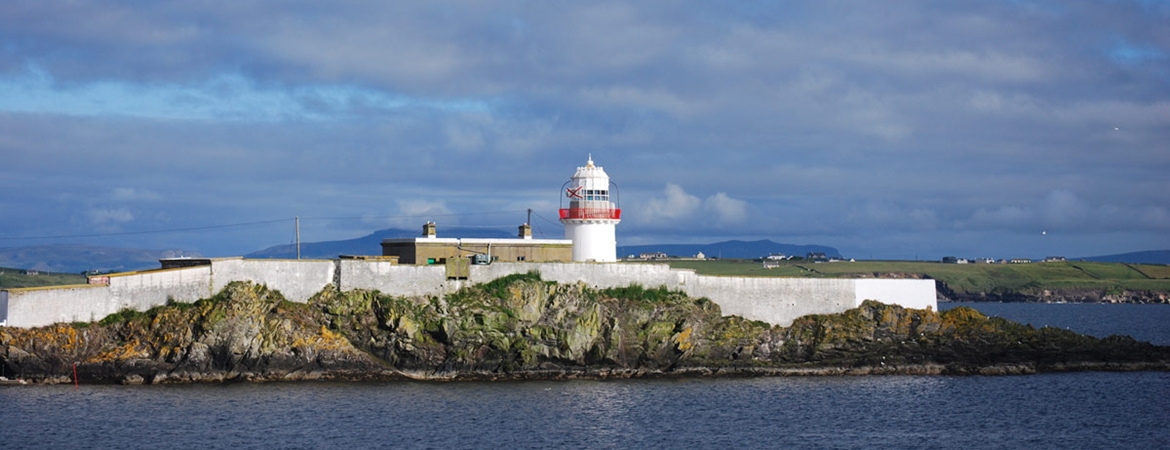This is a Harbour Light to light the passage from St. John's Point to inner channel and past the rocks to the anchorage within Killybegs Harbour.
Mr Drury, the Inspecting Commander of the Coast Guard, wrote to the Ballast Board on 21st April 1832 recommending that a light should be placed on Drumanoo Point. George Halpin, Inspector to the Ballast Board, agreed that a light was necessary but recommended Rotten Island instead.
The Ballast Board approved a light on 7th November 1833 and Statutory Sanction was obtained from Trinity House two weeks later.
The lighthouse and dwellings were designed by George Halpin and carried out by the Board's workmen under his inspection.
The tower of cut granite was painted white. The original light was fixed white catoptric third order screened to land 66 feet above high water and visible in clear weather for 12 miles. It was first exhibited on the 1st September 1838 before completion. The cost at the end of 1839 was £8,697.19.4.
On 15th September 1836 three men were drowned whilst returning from work on the rock due to the boat capsizing.
In 1910 the fixed light was changed to a fifth order dioptric, flashing with a character of one flash every three seconds. The new light was exhibited on 13th December 1910.
The station was converted to unwatched on 7th January 1959 and the dioptric lens with its revolving machine and vaporised paraffin incandescent burner were replaced by a new fourth order cylindric refractor lens with a mantle light source using dissolved acetylene from a battery of cylinders giving a candle power of 2,600 white and 500 in the red sector. This apparently was not as good as the old light and complaints were received from mariners using the harbour. Electricity was brought across the channel to the island by an overhead cable and the light converted to electric on 1st February 1963 with an increase in candlepower to 13,000 white and 2,600 in the red. The character remained the same, one flash every three seconds. An automatic changeover to batteries comes into operation if the ESB fails and an acetylene standby can be fitted by the Attendant if the battery standby fails.
The character was altered on 1st February 1965 to one flash every four seconds.
Mr Drury, the Inspecting Commander of the Coast Guard, wrote to the Ballast Board on 21st April 1832 recommending that a light should be placed on Drumanoo Point. George Halpin, Inspector to the Ballast Board, agreed that a light was necessary but recommended Rotten Island instead.
The Ballast Board approved a light on 7th November 1833 and Statutory Sanction was obtained from Trinity House two weeks later.
The lighthouse and dwellings were designed by George Halpin and carried out by the Board's workmen under his inspection.
The tower of cut granite was painted white. The original light was fixed white catoptric third order screened to land 66 feet above high water and visible in clear weather for 12 miles. It was first exhibited on the 1st September 1838 before completion. The cost at the end of 1839 was £8,697.19.4.
On 15th September 1836 three men were drowned whilst returning from work on the rock due to the boat capsizing.
In 1910 the fixed light was changed to a fifth order dioptric, flashing with a character of one flash every three seconds. The new light was exhibited on 13th December 1910.
The station was converted to unwatched on 7th January 1959 and the dioptric lens with its revolving machine and vaporised paraffin incandescent burner were replaced by a new fourth order cylindric refractor lens with a mantle light source using dissolved acetylene from a battery of cylinders giving a candle power of 2,600 white and 500 in the red sector. This apparently was not as good as the old light and complaints were received from mariners using the harbour. Electricity was brought across the channel to the island by an overhead cable and the light converted to electric on 1st February 1963 with an increase in candlepower to 13,000 white and 2,600 in the red. The character remained the same, one flash every three seconds. An automatic changeover to batteries comes into operation if the ESB fails and an acetylene standby can be fitted by the Attendant if the battery standby fails.
The character was altered on 1st February 1965 to one flash every four seconds.



